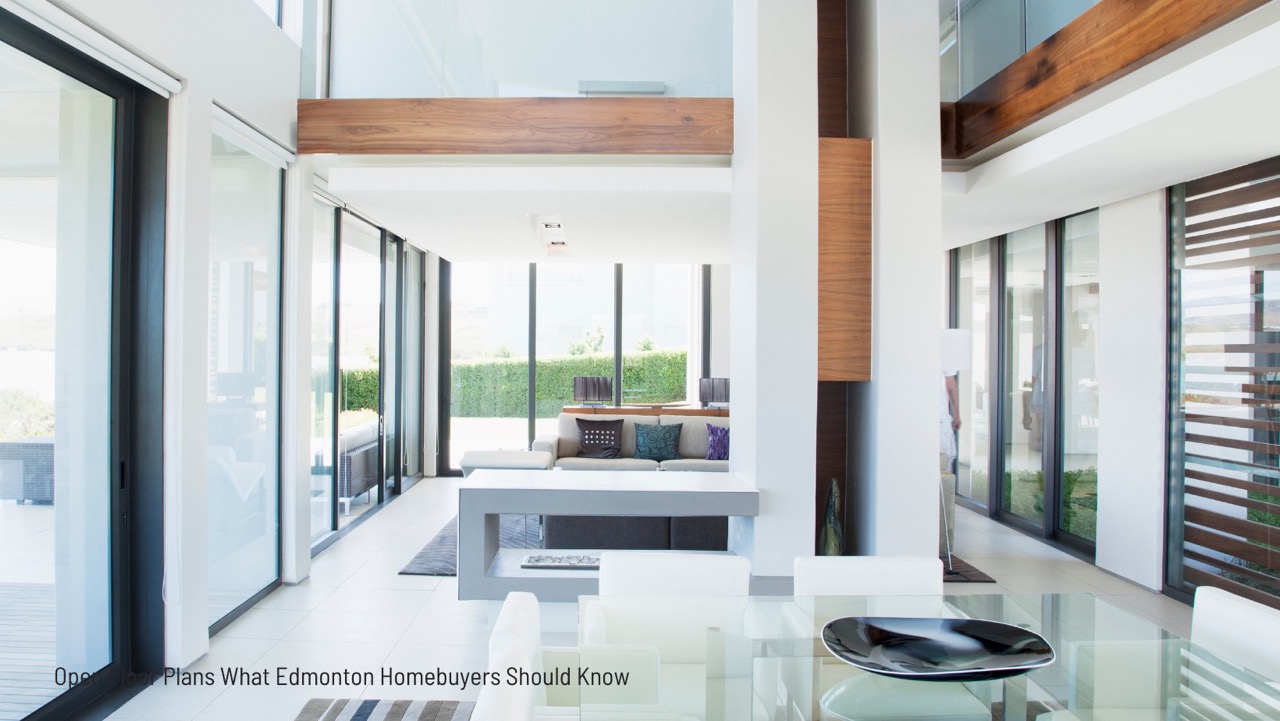When it comes to designing your new home, one of the most debated architectural features is the open floor plan. Over the years, open floor plans have surged in popularity, particularly in Edmonton, where spaciousness and modernity are highly valued. But is an open floor plan right for you? In this blog, we’ll explore the pros and cons of open floor plans to help you decide whether this layout suits your lifestyle and needs.
What is an Open Floor Plan?
An open floor plan is a design concept that eliminates walls and barriers between common areas such as the kitchen, living room, and dining room. This creates a seamless flow between spaces, fostering interaction and maximizing the use of available square footage. While it’s a hallmark of modern home design, open floor plans come with both benefits and drawbacks.
Pros of Open Floor Plans
1. Increased Natural Light
Open floor plans maximize the natural light that flows through your home. Without walls obstructing windows, sunlight can travel freely, creating a bright, welcoming atmosphere. Edmonton’s long summer days are perfect for homes with open floor plans, as they allow you to make the most of the natural light.
2. Enhanced Space for Entertaining
If you love hosting family gatherings or parties, an open floor plan is ideal. The seamless connection between the kitchen, dining, and living areas allows for easy interaction with guests while you cook or serve. This layout encourages mingling and fosters a sense of togetherness during events.
3. Improved Traffic Flow
With fewer walls, an open floor plan makes it easier to move around your home. This is particularly beneficial for families with young children or elderly relatives, as the unobstructed layout reduces the risk of accidents and makes the home feel more accessible.
4. Modern Aesthetic
The sleek, uncluttered design of open floor plans aligns with modern architectural trends. Open spaces make your home feel larger and more luxurious, appealing to Edmonton buyers who value contemporary design.
5. Flexibility in Furniture Arrangement
An open floor plan offers endless possibilities for furniture arrangement. Without walls dictating where pieces must go, you can experiment with layouts to suit your style and needs. Whether you prefer a minimalist look or cozy nooks, an open design allows for customization.
6. Better Supervision
For parents, an open floor plan provides a clear line of sight across multiple spaces. You can cook in the kitchen while keeping an eye on children playing in the living room, offering peace of mind without sacrificing functionality.
7. Increased Resale Value
Homes with open floor plans often have higher resale value due to their popularity among buyers. Edmonton’s growing real estate market favors modern, adaptable layouts, making open floor plans a smart investment for future returns.
Cons of Open Floor Plans
1. Limited Privacy
The biggest downside of an open floor plan is the lack of privacy. With no walls to separate spaces, it can be challenging to find a quiet area for work, relaxation, or personal time. For families with varying schedules or work-from-home setups, this can be a significant drawback.
2. Noise Levels
Open floor plans tend to amplify noise since sound travels more freely without walls to contain it. This can become problematic in busy households, especially when multiple activities are happening simultaneously.
3. Heating and Cooling Challenges
Heating and cooling an open space can be more challenging and costly. Edmonton’s winters can be harsh, and open layouts may result in uneven temperature distribution, requiring extra effort to keep your home comfortable.
4. Difficulty in Hiding Clutter
With an open floor plan, clutter is more visible. Keeping the kitchen spotless becomes essential since it’s often in full view of the living and dining areas. This can create pressure to maintain a constantly tidy home.
5. Higher Remodeling Costs
While open floor plans are versatile, creating defined spaces in an open layout often requires additional remodeling efforts. Adding walls, partitions, or other structural elements can be costly and time-consuming if you decide to change the layout later.
6. Cooking Smells and Smoke
Cooking odors and smoke can travel more freely in an open floor plan. Without walls to contain them, these smells may linger in your living areas, which can be bothersome over time.
7. Furniture Placement Challenges
While open spaces offer flexibility, they also require strategic furniture placement to create a cohesive look. Without natural boundaries, it’s easy for a space to feel disjointed or overwhelming if not carefully planned.
Is an Open Floor Plan Right for You?
Consider Your Lifestyle
If you’re someone who values interaction and loves entertaining, an open floor plan can enhance your daily life. However, if privacy and quiet are priorities, you may want to explore alternative layouts or hybrid designs that incorporate both open and closed elements.
Family Dynamics
For families with young children, an open floor plan offers visibility and connection. However, for larger families or multi-generational households, the lack of privacy may pose challenges.
Work-from-Home Needs
With the rise of remote work, having dedicated, quiet spaces is essential. Open floor plans can make it harder to concentrate unless you add partitions or dedicate specific areas for work.
Budget and Long-Term Plans
If you plan to stay in your home for years, think about how your needs might change. An open floor plan may feel ideal now, but consider whether it will accommodate future changes, such as children, pets, or aging parents.
Hybrid Floor Plans: The Best of Both Worlds?
For homeowners who want the benefits of an open floor plan without its downsides, hybrid layouts offer a solution. These designs combine open spaces with strategically placed walls or partitions to create balance. For instance:
- Use glass partitions or sliding doors to separate areas while maintaining the flow of light.
- Create semi-open spaces by incorporating partial walls or bookcases.
- Use rugs and furniture arrangements to define zones within an open area.
Hybrid layouts allow you to enjoy the spaciousness of an open floor plan while addressing concerns like noise, privacy, and clutter.
Maximizing the Potential of an Open Floor Plan
If you decide an open floor plan is right for you, here are some tips to make the most of it:
- Invest in Smart Storage: Use furniture with built-in storage to keep clutter at bay.
- Focus on Zoning: Use area rugs, lighting, and furniture to define different spaces within the open layout.
- Optimize Ventilation: Install a high-quality range hood in the kitchen to minimize cooking smells.
- Use Soundproofing Materials: Add soft furnishings like carpets, curtains, and cushions to absorb noise.
- Plan Your Furniture Layout: Choose furniture that complements the flow of your open space and avoids creating visual clutter.
Conclusion
Open floor plans offer undeniable benefits, from increased natural light to better spaces for entertaining. However, they also come with challenges, such as noise and a lack of privacy. When deciding whether an open floor plan is right for your new Edmonton home, carefully consider your lifestyle, family dynamics, and long-term needs. If you’re still unsure, hybrid floor plans can provide a happy medium, offering the flexibility and modernity you crave while addressing potential drawbacks.
Have more questions about Open Floor Plans What Edmonton Homebuyers Should Know?
Contact Chris Reid Edmonton REALTOR®.
For more insights into Edmonton’s real estate market, follow me on Facebook, Instagram, and YouTube. Stay updated on the latest new build opportunities and exclusive deals!

 Facebook
Facebook
 X
X
 Pinterest
Pinterest
 Copy Link
Copy Link

